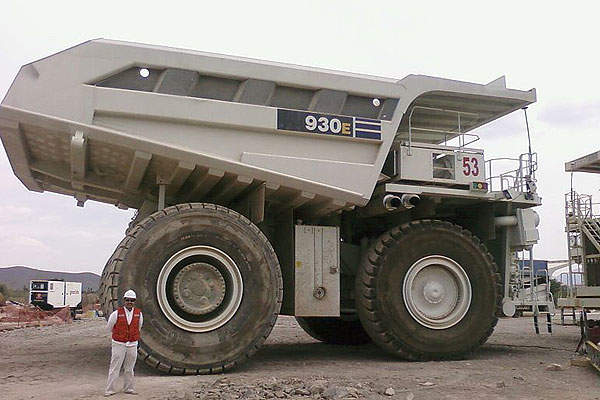Jwaneng is an open-pit diamond mine situated in South Central Botswana, approximately 170km south-west of Gaborone. The mine is being expanded to include an underground mining operation.
Debaswana, a 50/50 partnership between De Beers Company and the Government of Botswana, owns the mine.
It was discovered in 1972 and reached full production in July 1982. The mine was officially inaugurated in August 1982.
An underground expansion of the mine is currently ongoing. The Board of Debswana approved a $1bn investment for a key development phase of the underground expansion in January 2024.
Location
The Jwaneng diamond mine is located approximately 170km south-west of Gaborone in the south-central part of Botswana, Southern Africa.
Jwaneng open-pit mine geology and reserves
The Jwaneng open-pit mine consists of Paleoproterozoic-aged sedimentary rocks occurring as a collection of tilted and displaced blocks with dolomites at the base. The resource consists of north, south, and centre volcanic pipes.
Jwaneng is the eighth biggest diamond mine in the world with estimated reserves of 88.3 million carats or 70.1 million tonnes (t) grading 1.26 carats per tonne of diamond as of December 2012. The mine has an average production rate of 12 to 15 million carats per year.
Underground expansion details
The development phase of the underground expansion known as exploration access development will establish a drilling platform to enable sampling of the kimberlite pipes.
It will also act as the early access decline for the underground mine to develop essential infrastructure to support future expansion stages of the project.
The initial works are expected to commence in May 2024. The project will be developed in two further phases after the access development phase. Phase-one mining operations are expected to begin in 2028, ramping up production by 2032.
The underground operations will exploit resources at depths of approximately 1,000m below the surface. Underground mining methods such as block-, sublevel, and incline caving are planned to be employed.
Mining activities
The Jwaneng diamond mine has a current depth of 452m, which is expected to reach 816m by 2034.
The kimberlite deposits at Jwaneng are mined as a series of cut-downs into the earth. P&H 250XP blast-hole machines are used for the drilling.
An in-pit crushing method is applied at the mine. The recrushing plant processes the primary crushed ore and prepares it for diamond recovery. The dense-medium cyclones separate the waste from the diamonds after the secondary crushing.
The mining fleet includes the advanced Komatsu 930 haul trucks and Bateman semi-mobile crushers. Gemcom integrated mine production and management system is used for ore transportation. The ore is carried to the processing plant using 250t payload capacity dump trucks.
Processing plant at the Jwaneng diamond mine
The ore produced at Jwaneng is processed at the Aquarium project, a dense media separation-based processing plant.
The Aquarium processing plant comprises a completely automated recovery plant (CARP) and a fully integrated sort house (FISH). The Aquarium facility applies laser and X-ray sorting technology for diamond recovery.
The ore concentrate from the main treatment plant and the recrush plant is treated at the CARP facility. The FISH facility handles the diamonds recovered by the CARP facility.
Construction activities
Major construction activities include the construction of the Cut 8 expansion project, the Jwaneng resource expansion project, and a modular tailings treatment plant.
The construction of the $3bn Cut 8 expansion project began in 2010 to extend the mine life to 2028 while providing access to 95 million carats of diamonds.
The expansion delivered its first ore in 2017. The infrastructure and plant upgrades for the expansion project were completed in September 2012.
The construction of a modular tailings treatment plant commenced in 2013 with a capacity to treat 2.5 million tonnes per annum and is expected to produce 18 million carats in 20 years.
The $2bn Cut 9 extension project is also progressing. It will further extend the life of the mine to 2035 and is expected to yield 53 million carats of rough diamonds.
Contractors involved with the Jwaneng mine development
SRK Consultants was awarded the contract for conducting detailed probabilistic stability analysis for the Cut 8 project.
The engineering, procurement, and construction management services contract for installing the mine surface infrastructure was awarded to Fluor, an engineering and construction company. The contractual scope also included the earthworks, civil construction, pilings, structural steel erection, and electrical installation.
Majwe, a joint venture of Leighton Africa, Basil Read Mining and Bothakga Burrow, was awarded the contract for providing mining services for the Cut 8 phase two. The contract services included mine scheduling, drilling and blasting, waste removal, and limited ore mining.
Otraco, a tyre management solutions provider, was awarded the contract for tyre management services.
Construction and mining equipment provider Komatsu provided 16 930E haul trucks and other ancillary machinery for the Jwaneng’s Cut 8 project.
Kentz, an engineering and construction company, was awarded the contract for the procurement, fabrication, erection of structural steel, and cladding for buildings and conveyors.







